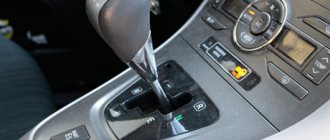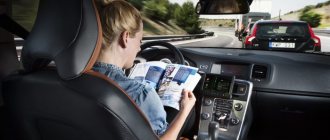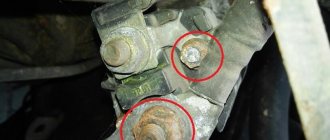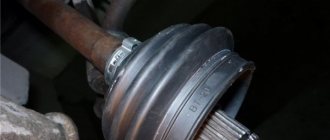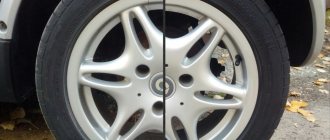Cars with automatic transmission are very popular today. They are bought not only by novice drivers, but also by experienced drivers. The automatic gearbox is convenient and easy to use, especially for beginners.
With such a car, the risk of accidents is much lower, since while driving the driver is not distracted by changing gears and various manipulations with the clutch pedal.
In fact, only one foot is used for two pedals - gas and brake. But, despite the comfort, convenience and ease of driving, automatic transmission requires careful handling. In other words, not everyone knows how to properly operate and maintain a car with such a gearbox.
Technical side of the issue
Automatic transmission.
Towing a vehicle with an automatic transmission is permitted, but with some restrictions. You need to tow a car with an automatic transmission in neutral. Even in this position, when the machine moves, rotational movements are performed by the entire gearbox mechanism. The transmission is not designed for this kind of load - this will lead to rapid overheating of the unit, which may even cause its failure. Plus, the oil pump servicing the automatic transmission performs its functions only when the power unit is running. If you drag a car with the engine turned off, the elements of the automatic transmission will work without the supply of lubricant mixture, which can lead to premature failure of the device.
Please note that cars equipped with an automatic transmission and an all-wheel drive system are best transported using a tow truck; this is often indicated by the manufacturer in the vehicle’s operating instructions. The machine must be moved by lifting the front or rear axle; using a hitch for transportation is not advisable.
It is permissible to use a car equipped with an automatic transmission as a tow vehicle if such a possibility is indicated in the vehicle manual. Many automatic transmissions are not designed for the additional loads that arise when using the car as a towing vehicle.
Compromise solution
Thus, according to experts, many cars equipped with an automatic transmission can act as a tug and tow vehicle. But you can only travel up to thirty kilometers in this way. The speed should not exceed 30 km/h.
If you need to continue to pull the car further, then after the 30-kilometer mark it is necessary to give the automatic transmission a rest. Otherwise it will overheat. This will entail expensive repairs. In addition to tips and recommendations for specific cars, there are general rules that have already been partially discussed at the beginning of the article. This is towing another car with an automatic transmission in second or third gear. If a car with an automatic transmission needs to be pulled, then the selector is set to the neutral position.
Transporting the machine without risk
Rigid coupling option.
Automatic transmissions on different car models may have certain design features, so the ability to tow a car with an automatic transmission must be carried out taking into account the recommendations of the car manufacturer as set out in the vehicle’s operating instructions. Particular attention should be paid to:
- the distance over which the car is allowed to be towed;
- the speed at which this type of transportation is carried out
For different machine manufacturers, the above parameters may differ significantly.
Vehicles equipped with a three-speed automatic transmission are transported to a maximum distance of 25 km/h at a speed of 40 km/h. It is permissible to drag a vehicle with a four-speed (or more) automatic transmission at a speed of 50 km/h over a distance of 50 km. If you need to cover a longer distance, then every 30 km the car is stopped and the transmission is allowed to cool. Before towing a vehicle equipped with an automatic transmission, you must perform the following steps:
- Add ATF mixture to the maximum mark to increase the amount of lubricant and protect parts from overheating. After transportation, excess liquid must be drained; to do this, you should use the services of specialists at a service station.
- Switch the selector to neutral position.
- Transportation should be carried out using a rigid hitch.
- If possible, towing should be done with the engine running, then there are no restrictions regarding travel speed and distance. When the car engine is turned off, towing is carried out with certain restrictions.
Compliance with the rules for towing cars with automatic transmission allows you to keep the transmission in working condition. Sudden movement of the vehicle while towing can permanently damage the automatic transmission.
If towing is performed incorrectly, the following consequences may occur:
- torque converter failure;
- failure of the motor pumping oil in the box;
- premature wear of the gears, this situation occurs if you drag the car with the selector engaged in position D.
We recommend watching a video on how to properly tow a car with an automatic transmission:
Consequences of transporting a car with an automatic transmission without following the rules
It is important to adhere to the manufacturer’s advice and practice-developed rules for towing a car with an automatic transmission because otherwise the transmission may be seriously damaged due to overheating and insufficient lubrication. The most common faults are presented in the table below.
| Type of malfunction | Nuances |
| Torque converter module burnout | One of the most serious consequences observed if towing is incorrect, and is expressed in the machine slipping or its complete loss of performance. Replacing this component can cost up to 5% of the total price of the vehicle. |
| Melting of gearbox components | Signs of slipping are similar to those above. Repair involves replacing failed parts. |
| Premature wear of machine elements | It is expressed in the transmission slipping in certain operating modes, primarily when moving forward. To return the transmission to working condition, it is necessary to replace worn parts. Most often you have to change clutches. |
Read
What is the difference and how does a robotic gearbox differ from an automatic gearbox?
Other typical breakdowns that may occur if you tow a car with violations are:
- failure of the oil pump;
- gear failure;
- destruction of soft internal components in the variator box;
- malfunctions of the electronics in the robot box.
Each of these problems requires expensive repairs, which is why it is so important to tow according to the basic rules.
Towing vehicle equipped with an automatic transmission
A car equipped with an automatic transmission as a tug.
How to tow an automatic transmission? When starting transportation, read the manual for the car; it specifies the speed, distance and tonnage with which a car with an automatic transmission can be used as a tug. If it is not possible to read the instructions for the car, follow these recommendations:
- Use a rigid hitch for towing.
- The weight of the towed vehicle must be less than the weight of the vehicle acting as a tow.
- Position D of the automatic transmission selector is unacceptable; manual mode and 2nd or 3rd gear are used. You should not engage in higher gears, as this will create additional loads. At lower speeds, the transmission heats up more slowly.
- The “leading” car must move away slowly and smoothly, move without sudden braking or jerking; any sudden movements can damage the automatic transmission.
Weaknesses of automatic transmission
The practice of using automatic transmissions has shown that they have two “Achilles heels” - overload and overheating.
Ideally, such gearboxes are designed for use in urban conditions and on homogeneous surfaces. Any changes to standard operating conditions are fraught with consequences.
There are several negative points here:
- Slipping. When the wheel rotates quickly, the automatic transmission begins to upshift. Then the driver releases the gas, but the speed remains high, which is bad for an automatic transmission. At this moment, the gearbox experiences maximum overload. To avoid problems, when slipping, you must turn on manual mode. In this case, the automatic transmission is fixed in one gear, and the likelihood of overheating is reduced to zero.
- Surface change. There are often situations when wheels slip on a slippery road and then fly off onto a hard surface. As a result, the wheels stop and the automatic transmission takes a hit. The latter can break the shafts, which is quite possible. Also, friction discs suffer from such impacts, which can slip upon impact.
- Overheat. The automatic transmission radiator is designed for operation under normal driving conditions. If the car starts to slip for a long time, the device quickly heats up and the radiator is not enough to dissipate the accumulated heat. If the car is standing and slipping in one place, plastic valve bodies and solenoids are at risk. When the corresponding signal appears on the control panel, the automatic transmission should be allowed to rest and the car should be turned off for 20-30 minutes. After slipping, it is necessary to check the oil and replace it if darkened. All plastic elements may also melt.
As for SUVs, their automatic transmission can withstand a lot more load. In addition, such cars have low gears that are engaged manually or automatically.
Their essence is the absence of high speeds, which eliminates overheating of the automatic transmission and consequences for its elements.
It is SUVs, if we talk about automatic transmissions, that are most suitable for towing a car with an automatic transmission.
Bottom line
A car equipped with an automatic gearbox can be towed in desperate situations when it is not possible to use the services of a tow truck. Towing such cars requires the driver to know the features of his car; before starting transportation, you should read the manual for the car and adhere to the manufacturer’s recommendations regarding the distance over which the vehicle can be towed, as well as the speed of its transportation. Violating the restrictions regarding speed and towing distance can lead to overheating of the automatic transmission and its premature failure.
What is the difference between manual transmission and automatic transmission when towing?
First of all, you need to understand this aspect so that it becomes clear why you cannot tow an automatic in the same way as cars with a manual transmission. In a manual transmission, only one gear rotates in neutral. At the same time, if the engine is not running, the lubrication process does not stop, which ensures safety even if the car is pulled for hundreds of kilometers.
With a machine gun everything is much more complicated. In the neutral position of the box, the entire mechanism works when moving. And the lubrication system is carried out using a pump driven by the engine. That is, if the motor is turned off, the mechanism inevitably overheats. To avoid such problems, you must strictly follow the recommendations outlined below.
How does everything work from a technical point of view?
After starting the engine, the oil pump starts, which disperses the oil through the parts of the automatic transmission.
If the engine is not running, then there is also no oil supply to the gearbox. The result is that gearbox elements wear out and may fail.
Another feature of the “automatic” is that while the car is being towed, the entire gearbox mechanism operates, as during normal operation.
It turns out that the gears are left without lubrication and quickly overheat.
The result depends on a number of factors - the duration of towing, the type of automatic transmission, the quality of components, and so on.
At best, you can get by with an oil change, and at worst, serious repairs due to the wedge of the gears. This cannot be allowed, because repairing a machine is an expensive service.
That is why manufacturers immediately prohibit towing on a flexible or rigid chain, giving preference to full loading on a tow truck.
It is important to read: Automatic transmission malfunctions and ways to eliminate them.
Additional considerations for towing vehicles with automatic transmission
It’s probably easy to guess that the most unprotected component when towing is the gearbox itself. Since the car is turned off, which means nothing is working inside, as a result, there is a real threat to the automatic transmission. To reduce the heating rate of the automatic transmission to a minimum, you need to pour a small amount of oil into it before towing.
Towing a car
This procedure really helps. After all, the rate of its heating will depend on the amount of oil in it, that is, the more, the longer the heating will take. Even in a fixed state, it can have a significant heat capacity. The main thing is to remember to pour back the excess afterwards, as too much can also cause damage.
What distance in km can you tow a car with an automatic transmission?
You need to know how long, according to the rules, you can tow a faulty car with an automatic transmission. You should look for this information in the manual for your model. If you can’t find anything there, follow the generally accepted rules that apply to most cars:
- If a three-speed gearbox is installed, you can tow at a speed of no more than 35 km/h. In this case, the maximum possible distance is 35 kilometers, but may vary depending on the air temperature. In hot weather it is better to reduce it by 10 km, and in cold weather you can increase it by 15 km.
- When you need to tow a new car with more than three gears, the permissible speed increases to 50 km/h. In this case, the distance should not exceed 50 km, but it can also vary if the air temperature is high or low.
If the distance is greater than the specified limits, you need to stop periodically. The parking time should be at least half an hour, and in hot weather - at least an hour. Compliance with the speed limit is no less important: even when exceeding 5 km, the parts heat up much more.
Towing with a rigid hitch
The main way to tow a car with an automatic transmission is to use a special metal device - a rigid hitch. This device allows you to maintain the same distance (at least 4 meters) between vehicles. Welded structures made of steel pipes with welded eyes are often used as rigid couplings.
Attention: Towing a car with an automatic transmission using the rigid automatic coupling method during icy conditions is unacceptable! Under these conditions, the partial loading method (raising the front of the machine) is used. In this case, a special vehicle equipped with a crane is used.
Is it possible to tow an automatic car with a trailer? According to traffic rules, such towing is strictly prohibited.
In what cases is it necessary to tow a car in winter:
- malfunctions as a result of a traffic accident;
- lack of fuel;
- getting caught in snow drifts.
Basic rules for towing in winter:
- The towed vehicle must be equipped with a special hazard warning light.
- If this is not possible (the battery is discharged, the car will not start), a special sign is installed at the rear, notifying about an emergency stop.
- The towing vehicle must weigh more than the vehicle being towed.
- No passengers are allowed in the towed vehicle.
Roadside assistance - to take or not to take
And one more question, the answer to which we will give today, is “is it possible to tow another car with an automatic machine”? Anything can happen on the road, and the bonds of automotive brotherhood are strong thanks to a simple principle - if you help, they will help you!
Imagine, it’s night, there’s a highway, you can’t call the towing service, but on the road there’s only you and a car enthusiast who really needs your help, and you have an automatic transmission. Without creating any intrigue, let's say that it is definitely possible to tow another car automatically, however, even in this case, you will need to follow a number of simple rules in order to neutralize the consequences of additional load on your transmission:
Car with automatic transmission as a tow vehicle
Manufacturers, answering the question “is it possible to tow another car with an automatic car,” recommend avoiding such situations. If there are no other solutions to the problem, then you need to follow certain rules.
So, it is better to give preference not to a traditional cable, but to a rigid coupling. As already noted in the general recommendations, the weight of the towed vehicle should not exceed the weight of the towing vehicle. The speed does not exceed 30-40 km/h. The transmission should not be in Drive.
It is better to set it to position “2” or “3”. Experts also recommend downshifting. This will help reduce the load on the transmission mechanism.
How to properly tow a car in principle
Focusing on technical issues, car enthusiasts often lose sight of organizational ones. The first step is to look in the trunk for a cable whose carrying capacity exceeds the weight of the car three times. At the same time, it is necessary to eliminate uncertainty in the operation of the brakes and steering by checking the whole thing.
For your information. You cannot tow on a rope in icy conditions. The maximum speed of the exercise is no more than 50 kilometers per hour.
It is necessary to agree in advance on the method of communication:
- blinking "distant";
- normal multiple signal;
- mobile phone switched to speakerphone mode.
- the cable must be bright and have signal flags;
- attach the connecting link diagonally (this ensures shock smoothing, transparent visibility, and the wheel does not hit the rope);
- turn on the ignition so that the steering wheel lock does not operate;
- activate the “thank you” or hang the emergency triangle on the trunk.
The driver should change lanes in advance and turn in a maximum arc, since the trailer always cuts off the trajectory. When driving a faulty car, you need to monitor the tension of the cable: when it sags, brake smoothly.
Differences between manual transmission and automatic transmission when towing
The differences between manual transmission and automatic transmission when towing are due to the characteristics of the two types of transmission. Since manual and automatic transmissions have different structures and operating principles, they operate in different modes when towing.
- With a manual transmission, when the lever is in neutral, only one gear rotates when towing.
For this reason, transporting such a vehicle is much more difficult than a car with a manual transmission.
What about the variator?
The variable automatic transmission deserves special attention. Here, to find out whether you can tow another car with your car, you need to carefully study the instructions. Therefore, for some CVT automatic transmission models, it is recommended to install the box in the neutral position.
For others, the engine must be running. For third-party vehicles, towing may be completely prohibited.
Is it possible to tow a car with an automatic transmission?
There is no definite answer to this question, since much depends on the specific car model, the type of automatic transmission and the manufacturer’s recommendations.
Many of them recommend exclusively a tow truck as a means of transporting cars with automatic transmissions. There is also a dependence on the type of automatic transmission, the number of gears in it, the type of drive and other conditions.
Therefore, in the question of whether it is possible to tow a car with an automatic transmission, it is better to use the operating manual for a specific vehicle.
However, if in desperate situations there is an extreme need for towing, then in order not to damage the car, you should follow the rules, which will be discussed below. If followed, this procedure should not cause much harm.
Tips and recommendations from experienced car owners
Experienced drivers advise pouring an extra liter of oil into the transmission before towing a car with an automatic transmission. This will provide additional lubrication of the elements and prevent them from overheating and damage.
If you intend to tow one car with another with rear-wheel drive, according to experts, for ideal conditions, you should disconnect the automatic transmission from the drive wheels, for which experts recommend removing the driveshaft. If this is not possible, the rear axle must be suspended.
Most experts do not recommend towing vehicles with all-wheel drive. The best solution if it is necessary to transport them is to call a tow truck, however, if in the end this kind of possibility is not possible, then one of the bridges must be hung up; a traditional hitch cannot be used.
In general, transportation with an automatic transmission in tow can be quite safe for the transmission if you follow the manufacturer's recommendations and the advice of experienced specialists.
Why can't you tow a car with an automatic transmission?
Many car owners have no idea under what conditions and why they cannot tow a car with an automatic transmission, since they have no idea about the processes occurring in the automatic transmission during forced transportation.
Since the oil pump does not work when the engine is turned off, the operating mechanism in the gearbox experiences oil starvation: the unit does not properly cool, and increased friction leads to rapid wear of parts and can even lead to gear wedges or failure of fluid couplings and bearings.
Therefore, towing a car with an automatic transmission with the engine turned off is usually prohibited by the manufacturer.
Towing conditions and its availability are usually described in the vehicle's owner's manual. If an urgent need arises, but the manual is not at hand, then there are certain rules that need to be remembered.
As a rule, towing a car with an automatic transmission is prohibited:
- for all-wheel drive vehicles;
- if the level of transmission oil (ATF) in the gearbox is insufficient;
- Towing with a soft hitch is not allowed, since sharp shocks when driving with a soft hitch have an extremely negative impact on the car.
A bit of technology
How do automatic transmissions work in general? Despite all the differences in characteristics and design, the machines have one common quality - oil lubricates the internal mechanisms only when the power unit, that is, the engine, is functioning. If the engine is turned off, the gearbox will run dry, which causes heating, and then overheating and failure of its elements if a number of recommendations are not followed, which we will discuss below.
If you don't follow our recommendations, you may well end up needing a very expensive overhaul or replacement of the automatic transmission, so don't get carried away by high speeds and long distances while driving a towed car.
Towing a car with automatic transmission
For forced transportation of a vehicle with an automatic transmission, strict rules must be followed to avoid automatic transmission breakdown and costly repairs.
The rules for towing a car with an automatic transmission are as follows:
- The weight of the towing vehicle must be higher than that of the towed vehicle. Moreover, the greater the difference in favor of the tug, the better.
- First, you need to check the transmission fluid level and, if there is a deficiency, bring it to the maximum possible.
- To unlock the steering wheel, turn the ignition key and start the engine.
- Place the gearbox selector in the neutral “N” position.
- It is necessary to monitor the temperature of the transmission and, if necessary, take breaks while driving.
The speed during forced transportation and the distance over which the vehicle can be towed depends on the number of gears in the box.
In this case, the so-called “5×5” rule or its variations (3×3, 4×4) applies:
- with a 3-speed automatic – 30 km/h and a distance of 30 km;
- with a 4-speed - 40 km/h and 40 km;
- with a 5-speed - 50 km/h and 50 km, etc.
As you can see, the distance and speed of movement is determined very simply: you need to multiply the number of gears in the box by 10. The resulting numbers will be the limitation.
The time of towing and “rest” is of the same importance: for every 50 minutes of movement, it is necessary to give the towed vehicle 50 minutes of “rest” so that the box cools down.
If this happened
So, you were driving along the highway, and your car stopped for unknown reasons, you can’t start it, and you can’t call a tow truck. By the way, let us immediately note that you should resort to driving a car equipped with an automatic transmission with the help of a tow only as a last resort.
Towing a car is always a risk of damaging gearbox components; try to avoid this method of transportation. But if there is no choice left, then you should know how to properly tow a car if it has an automatic transmission on board.
7 simple rules from our portal that must be followed to maintain the functionality of your automatic transmission:
1.Before towing your car, be sure to use transmission fluid for the automatic transmission, which will allow you to raise the oil level in the box, minimizing the damage from driving with the engine off.
2. Towing a vehicle equipped with an automatic transmission is only possible with the gear shift knob in the “N” (neutral) position.
3.If there is a three-speed gearbox, the towing speed cannot exceed 30 kilometers/hour for no further than 30 km.
4. If you have an automatic transmission with 4 stages or more, you can drive 50 km in tow at a speed of 50 km/h.
5. Load the car as much as possible when towing if the brakes have failed. If necessary, transfer passengers and load luggage from the car that is towing you
6.Cooling by additional methods will definitely be required if you have a trailer, since the load on the gearbox components will increase. Stop often to let the parts cool down.
7.Smoothness and uniformity of movement is the last key to the success of your venture. Take your time - driving fast in such a situation is definitely not recommended.
Towing a car with an automatic transmission with the engine not running
If for some reason it is not possible to start the engine, then towing a car with a non-working engine is preferable using a tow truck.
In this case, you can either completely load the vehicle onto the platform, or carry out partial loading with the front or rear axle hanging.
The same rules apply when towing a four-wheel drive vehicle with an automatic transmission: it is better to immediately call a car tow truck to avoid breakdowns.
If it is not possible to call a tow truck, or the cost is prohibitively high, then you can try to transport the vehicle with the engine turned off.
The transportation rules in this case are similar to towing a car with the engine running:
- Add transmission oil to the top.
- We use an exclusively rigid coupling; it is advisable to use a trolley with a partial load and one of the bridges hanging out.
- You need to monitor the level and temperature of the transmission oil and stop to rest if necessary.
However, even if such conditions are met, there is no guarantee that the box will not fail, so towing in this mode is an exceptional measure and should be used in case of emergency.
Doubts
Sometimes towing is simply necessary. For example, a car is stuck in the snow and for some reason there is no way to call a tow truck or rescue service. According to theory, every owner of a car with an automatic transmission knows that it is better not to engage in towing.
But what if there are no other means of help? And if we think logically, then the automatic transmission pulls loaded trailers quite tolerably. How can I connect another machine to a worse cable? There shouldn't be any particular difficulties. Of course, no one wants to risk an automatic transmission, but leaving a friend or just a stranger on the track is simply rude. Drivers are special people, and driver solidarity still exists among them. But many motorists have not even read the instructions for their car in order to say for sure whether it is possible to tow another car with their car.
Basic conditions for towing a car with automatic transmission
- The vehicle is towed at a speed that is strictly regulated by the instructions for this vehicle model. If you don’t know what is written in the instructions and there is no way to find out (there’s no one to even call and there’s no internet nearby), then you can adhere to these most common restrictions: a car with a 3-gear transmission can be towed at a speed of 30 km/ h at a distance of up to 35 km. For vehicles equipped with gearboxes with 4 or more gears, the towing speed will be 50 km/h for a distance of up to 50 km.
- Before towing a car, you should check the lubricant level in the automatic transmission. Throughout the entire towing period, it is worth monitoring the operating temperature of the gearbox and promptly taking measures to cool it if necessary.
- The speed selector must be set to neutral (N). This can be difficult to do when the engine is not running, since the automatic transmission design may be blocked. To remove the lock, you usually need to open a special plug behind which the lock switch is hidden and press on it with a regular screwdriver, while simultaneously moving the lever to neutral.
- When towing a car with an automatic transmission, it is preferable to use only a rigid type hitch, which eliminates the occurrence of jerks and sudden stops while driving.
If the car needs long-term transportation, then you should immediately use the services of a tow truck (which can be ordered, for example, here) with the possibility of full or partial loading of the vehicle.
In any case, before carrying out any towing of a car, you should first (I will not tire of repeating this) look at the instructions for your car in order to avoid unpleasant situations. This document describes all the basic parameters under which towing of your particular car model is possible.
Its weight, permissible speed and transportation distance on a hitch, and additional information are indicated here. This information may differ significantly for different car brands. In some cases, towing a vehicle may be completely prohibited.
It is clear that not all drivers have such instructions with them. So what to do in case of unexpected car towing? Stick to the averages indicated earlier.
When towing, special attention should be paid to vehicles with all-wheel drive. In most cases, only a tow truck is suitable for evacuating such vehicles. But if this is not possible, towing such vehicles is carried out only in a position where the rear or front axle is raised.
How to tow correctly
Since the automatic transmissions installed on different car models can differ significantly from each other, it is best to see whether it is possible to tow another car with an automatic transmission in the car’s instructions. There you can also find information on how long you can pull the car and what speed to adhere to. Manufacturers may set different parameters. But it's rare that they ban towing entirely. Of course, such advice is suitable if the need for towing is known in advance and there is the opportunity and time to study the instructions. When this is not possible (and such situations happen very often), experts and experienced car owners recommend resorting to some kind of “golden mean”.

